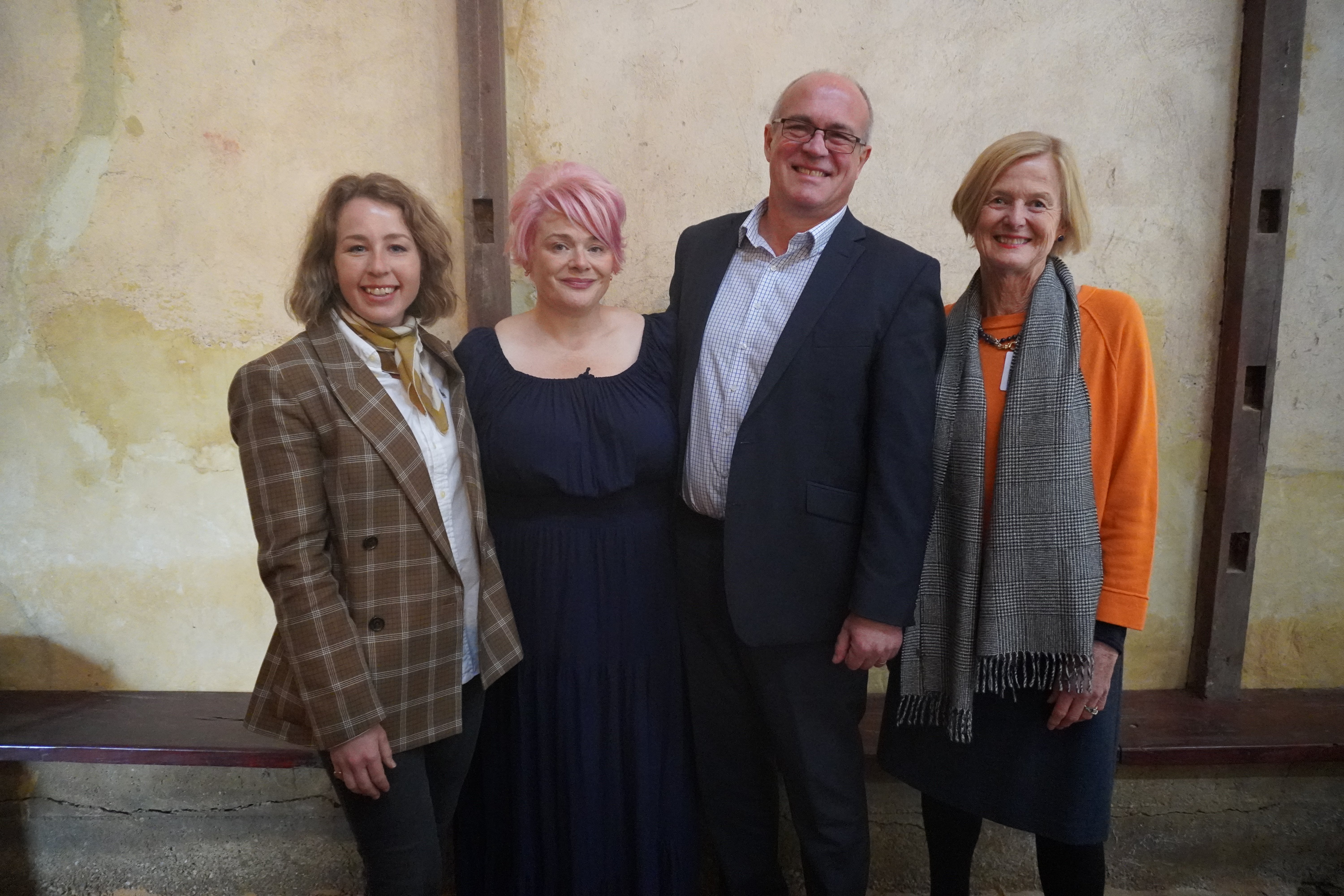Second SSF Annual Report released

Sheep Producers Australia chief executive officer Bonnie Skinner, SSF secretariat Sarah Hyland, SSF Sustainability Steering Group Chair, Dr Scott Williams, and Independent Chair of the SSF Board Lucinda Corrigan. Image: Edwina Clowes.
The second Sheep Sustainability Framework (SSF) Annual Report was released in May, delivering a sustainability scorecard for the Australian sheep and wool industry.
It was launched by Sheep Producers Australia chief executive officer Bonnie Skinner and WoolProducers Australia director Helen Carrigan, to about 40 industry stakeholders at Anlaby Station, home to South Australia’s oldest Merino sheep stud.
Bonnie told attendees the SSF Annual Report 2023, which tracks the performance of the industry over 58 key indicators, has cemented itself as a critical document in industry discussions, especially with Australia’s trading partners.
“Significant opportunities that exist for Australia’s sheep and wool industries, particularly globally, come from the growing interest in sustainably produced food and fibre,” Bonnie said.
“Capturing these opportunities lays the path for our industry to not only tell its story, but to also ensure we meet the ever-changing expectations and needs of our customers, investors, governments, consumers and communities.
“We know trust is built on transparency, and this document helps us to tell our story and show we are proactive in identifying areas where we need to make improvements.”
Helen, who is also a wool producer at Moree, NSW, said embedding the SSF in the industry has flow-on effects through the whole supply chain.
“As a producer, I’ve seen firsthand how the SSF relates on the ground to provide guidance to producers about what sustainable production entails,” Helen said.
"It’s so important to see this embedded in our industry and to have it recognised around the world.”
SSF Annual Report findings
SSF Sustainability Steering Group Chair, Dr Scott Williams, took attendees through the notable gains made in its reporting capacity over the past year. A range of new information was added in 2023, including 25 new baseline data points.
“When we launched the inaugural SSF Annual Report in 2022, just over half of the indicators were reported with data,” Scott said.
“Today, 91% of our indicators are reported with data and we are on track for 100% next year.
He said it was exciting to see the data sets grow, with many of the indicators now onto their third data point – building a scientifically based picture of what sustainable sheep production in Australia really looks like.
“You can’t monitor what you don’t measure, so the SSF Annual Report allows us to prioritise industry issues and monitor them over time.
“These metrics allow us to determine directional changes over time, highlight our successes, identify areas for improvement and demonstrate the sustainability credentials of one of Australia’s most important industries.”
Highlights
The latest report recorded directional improvements across 18 indicators with eight indicators holding steady.
One of the key metrics of the SSF is the industry’s net greenhouse gas emissions. The CSIRO reports net emissions generated from Australian sheepmeat and wool production in the latest reporting period (2020) was 9.49Mt CO2e, down from 10.21Mt CO2e in 2019 and 11.39Mt CO2e in 2018.
The percentage of producers who have completed the six-day Lifetime Ewe Management (LTEM) training with Australian Wool Innovation (AWI), a program of best practice adoption, has increased to 9.4% of all AWI-eligible wool levy payers (up from 8.1%).
Other highlights of the Sheep Sustainability Framework Annual Report 2023 include:
- The percentage of non-mulesed/ceased mulesed bales offered has risen to 15.8% (Merino) and 40.1% (non-Merino).
- There were zero fatalities in the sheep industry in the latest reporting period (2020-21).
- Sheep mortality on ships during export has declined to 0.14%.
- The percentage of Australians who believe Australians lambs are farmed and raised in a humane manner has risen to 55% (from 53%).
- Investment in wool research, development and adoption has increased 18.5% to $32.7m.
- Australia’s value share of global sheepmeat exports (45%) and global wool exports (75.5%) has risen.
- The percentage of sheep-grazing land achieving 50% ground cover is holding steady at 62.2%.
- Australia continues to be declared free from 12 major diseases.
- 91% of producers use vaccinations to prevent disease and protect their flock (new data).
- 50% of sheep producers generate and use renewable energy (new data).
Challenges
There have been directional declines in research, development, and adoption investment in sheepmeat, and the gross value of agricultural production for both sheepmeat and wool, while there was an increase in the number of serious injury workers’ compensation claims.
Independent Chair of the SSF Board and sheep producer, Lucinda Corrigan, said each SSF Annual Report was an expression of the commitment to continuous improvement across the industry.
“One of the most important functions of the Annual Report is to bring transparency to our industry and identify areas where we need to improve,” Lucinda said.
“We have a duty to our people, our animals and our consumers to strive for excellence in sustainability and continue to affirm the Australian industry’s position as among the best in the world.”
Scott reinforced to attendees at the launch how the sheep and wool industry is conscious of not ‘green washing’ its performance.
“This document is important to maintain our credibility and convey to our customers and our supply chain what the reality of sheep production is in Australia, and that we understand there are areas we need to improve and provide reassurance that we are working on them.
“For example, the SSF adjusted one of the metrics for ‘Caring for our sheep’ from ‘pain management’ to ‘appropriate pain management’ for the method employed, in response to the results of the recent National Producer Survey.”